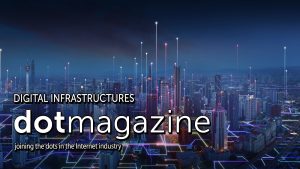Digital infrastructures are the essential, yet often overlooked, foundations that form the backbone of our interconnected modern world. They weave an intricate web that facilitates the flow of information, services and resources. In this month’s dotmagazine, it’s accordingly heartening to gain core insights from nine leading digital experts – pioneers driving innovation and sustainability while calling for the critical role of policymakers in shaping digital ecosystems.
First and foremost, Dr. Béla Waldhauser, Spokesperson of the Alliance for the Strengthening of Digital Infrastructures, specifies how high-speed networks and secure, reliable data centres are the bedrock of industry’s digital transformation. In reviewing specific movements in Germany, Béla is glad to note that the Growth Initiative aims to expand AI data centres and improve conditions for operators. However, he further emphasises that effective action must include streamlined regulations, reduced bureaucracy and practical support for implementing efficiency requirements. Béla also accentuates that digital technologies and solutions are essential to meeting today’s climate change challenges – which simply cannot exist without an ecosystem of digital infrastructures.
Cutting CO₂ emissions through digital innovation
On the strength of such key digital ecosystems, Roland Broch from eco foresees that digital technology could significantly cut Germany’s CO₂ emissions by up to 30% by 2050. He focuses on the sector’s importance in driving a greener future, highlighting that “data centres in particular play an integral role in achieving sustainability and reducing carbon emissions.” With digitalisation deeply intertwined with environmental sustainability, Roland advocates for strategies such as utilising waste heat, implementing advanced energy optimisation technologies, and leveraging AI to enhance operations.
In further pursuing the concept of greener data centres, Thomas Amberg from Ynvolve homes in on a range of essential steps – such as switching to a circular procurement model, adopting energy-efficient hardware and implementing innovative cooling solutions. Furthermore, Mustafa Keskin from Corning delves into the evolving landscape of data centre cooling solutions. As he envisions, “liquid cooling can help reduce the electricity cost for an entire data centre by up to 55%.”
A model for collaborative Internet governance
Turning to a wide range of digital infrastructures, as managed by Internet governance, it is clearly evident that ecosystems are always essential. To this end, Lars Steffen and Thomas Rickert from the eco Association explore the NETmundial multi-stakeholder process as a model for Internet governance, emphasising inclusivity and collaboration among diverse groups. Their analysis demonstrates how this approach enhances transparency and accountability in digital policy-making, making it a vital framework for addressing Internet governance challenges. The success of NETmundial illustrates the importance of engaging governments, private sectors, civil society and academia to maintain an open and beneficial resource for all.
The indispensable role of DNS in supporting the expanding digital economy
In further analysing digital infrastructure, Simone Catania from InterNetX analyses the indispensable role of Domain Name System (DNS) in today’s digital landscape. As he specifies, “DNS plays a pivotal role in today’s online-centric society and the growth of the digital economy, as virtually every email sent, website visited, or online service depends on this system.” As the digital economy expands, the importance of DNS infrastructure in sustaining business operations and driving innovation becomes increasingly evident.
Tackling cybersecurity risks in Industry 4.0
Digital infrastructures are likewise the foundation supporting technologies and processes that drive Industry 4.0 and smart manufacturing. Jasmin Jabbarpour from The Lisbon Council explains how the integration of IoT, AI and robotics is revolutionising manufacturing – but also introducing cybersecurity risks. As Jasmin explains, the TANGO project tackles these challenges by developing secure, trustworthy data management solutions. This protects intellectual property and enhances resilience against cyberattacks.
Bridging the AI adoption gap
Overall, in complementing the wide range of digital infrastructure efforts, the role of AI is undeniably fundamental. It’s therefore encouraging to learn that the “AI in Practice” initiative by the eco Association is making significant strides in facilitating AI adoption among German companies. Christine Neubauer from eco reveals that one-third of German businesses have yet to embrace the potential AI offers, and only 8% have a comprehensive AI strategy. To address this gap, Christine conveys how the initiative is providing valuable information, guidelines, and networking opportunities to help companies leverage AI for enhanced productivity, cost savings and resource efficiency.
All in all, the insights shared by these nine key experts emphasise the vital role that resilient digital infrastructure plays in fostering innovation, sustainability and economic growth. As digital ecosystems evolve, it will be crucial for industry leaders and policymakers to work together to harness these technologies’ full potential while effectively navigating emerging challenges.





